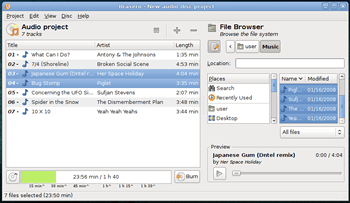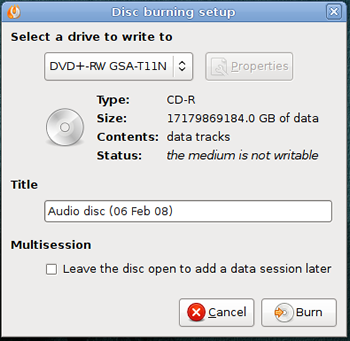Author: Kurt Edelbrock
Brasero will replace Serpentine as the CD-writing utility in the upcoming April release of Ubuntu 8.10 (code-named Hardy Heron). Brasero extends the functionality of Serpentine to include data CD and DVD projects, file integrity checking, and multisession support.
Why replace Serpentine, a dead simple solution for burning audio CDs? It features tight integration into the GNOME Desktop Environment, with support for Rhythmbox playlists and drag and drop file management from Nautilus, as well as the ability to extract audio from video files. Unfortunately, the application has no support for creating data CDs. You can fill that void by using the native CD-writing capabilities inside Nautilus, but Nautilus offers limited options for data project creation.
Brasero builds upon the functional shortcomings of Serpentine through the addition of data CD and DVD support, along with image creation and burning. Its interface relies on clear dialogs and minimal waste of screen estate, though it isn’t quite as intuitive as Serpentine — for instance, there is no way to easily switch between adding files and adding Rhythmbox data without resorting to using the hot keys or reaching for the View menu. Brasero supports multiple back ends to power the burning process, such as cdrtools, growisofs, and Libburn. This maximizes hardware compatibility with a slew of different writing devices. Burning and copying is as quick as with any application — Brasero includes on-the-fly CD and DVD recording for single- and multi-session projects. Its built-in audio previewing helps users make sure they pick the right song for the right album: you no longer have to worry about mixing up a song with another that has the same title.
 While Brasero integrates well with GNOME, it lacks some of the functionality found in K3b. Some of the missing features are relatively trivial. For instance, native disc-ripping capabilities are best completed with a separate applications, such as Sound Juicer or DVD::Rip. By using a separate application, you can take advantage of a better allocation of memory resources, which is especially important with an aging machine. But some of the feature differences are more significant. K3b supports a wider variety of media types, including eMovix, VCD, and mixed-mode discs. It provides audio normalization and cutting, which can be helpful for users without a lot of knowledge about sound editing. K3b also includes the ability to select from a series of different filesystem types, which can be useful for ensuring compatibility across a variety of operating systems.
While Brasero integrates well with GNOME, it lacks some of the functionality found in K3b. Some of the missing features are relatively trivial. For instance, native disc-ripping capabilities are best completed with a separate applications, such as Sound Juicer or DVD::Rip. By using a separate application, you can take advantage of a better allocation of memory resources, which is especially important with an aging machine. But some of the feature differences are more significant. K3b supports a wider variety of media types, including eMovix, VCD, and mixed-mode discs. It provides audio normalization and cutting, which can be helpful for users without a lot of knowledge about sound editing. K3b also includes the ability to select from a series of different filesystem types, which can be useful for ensuring compatibility across a variety of operating systems.
Yet K3b has some inherent downsides for Ubuntu and GNOME users that begin at installation. The program was written in C++ and relies on the Qt toolkit for its graphical interface, which may require extra packages be installed. Integration with GNOME leaves a lot to be desired — in a recent test I performed on my fresh installation of Ubuntu Gutsy, Nautilus didn’t automatically recognize the K3b project file extension, and the help feature required extra dependencies not calculated by aptitude. Also, the interface is relatively muddled:
 the large number of buttons present on the interface is reminiscent of burning software on a certain popular proprietary operating system. The extra dependencies degrade system performance when K3b is running. It is noticeably slower than both Serpentine and Brasero in a fresh installation of Ubuntu 7.10. Because of the large number of features included in K3b, it may make the burning process seem more complex for users than necessary.
the large number of buttons present on the interface is reminiscent of burning software on a certain popular proprietary operating system. The extra dependencies degrade system performance when K3b is running. It is noticeably slower than both Serpentine and Brasero in a fresh installation of Ubuntu 7.10. Because of the large number of features included in K3b, it may make the burning process seem more complex for users than necessary.
Brasero is not without its own flaws. It lacks any built-in documentation included with the application, though some help is available on the Internet. Documentation could be helpful for Brasero for both new and experienced users, especially when it comes to the less intuitive features. Also, because there’s no Preferences dialog, a help file might show users where they can locate options for specific features. Also, the file selection window, while preferable to a file tree, doesn’t force the width of the screen to the correct size, so if the screen is too small, a user will only see half of the file window, and the slider arrows won’t be activated as you might expect.
Yet Brasero is a better solution than Serpentine because it offers more functionality, and is better than K3b for simple data and audio burning projects that don’t require complex features. The intuitive interface and Rhyhtmbox integration minimize time spent locating files and make it easy to finish projects quickly. Though Brasero doesn’t have built-in documentation and has a few minor interface difficulties, it’s the strongest CD- and DVD-burning application on GNOME. Anyone who needs only basic functionality should be able to use Brasero exclusively.
Category:
- Desktop Software


